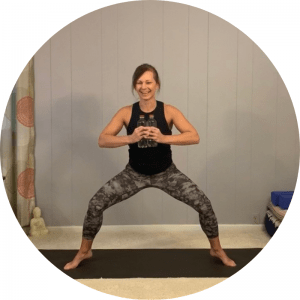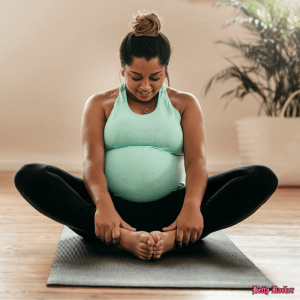 Congratulations on your pregnancy!
Congratulations on your pregnancy!
Whether this is your first or fifth pregnancy there can be so many questions.
A big question many women have is if it is safe to workout during pregnancy?
The short answer is YES! And in this post, you’ll find some video guides to modify poses you may be used to getting into and tips on how to successfully navigate your pregnancy while staying active.
But before you get busy with your squats and curls always consult with your healthcare provider before beginning any exercise program as they will be able to offer you personalized exercise guidelines based on your medical history.
Table of Contents
- Benefits of exercising while pregnant
- Exercises that are safe while pregnant
- Physical changes to expect during pregnancy
- Breathing, core and your pelvic floor
- Video Tutorial: Deep Breathing and Core Toning
- Postural changes during pregnancy
- Exercises to avoid during pregnancy
- Prenatal Exercise Variations, Modifications, and Tips for All Trimesters
- Video 1: How to Modify Forward-Facing Exercises
- Video 2: How to Modify Exercises Lying on Your Back
- Video 3: How to Modify Standing Exercises for Safety, Comfort, and Balance
- Contraindications for exercising
- Video 4: How to Modify Abdominal Core Exercises and Twists
- Video 5: How to Modify Explosive and High Intensity Exercises
- BONUS VIDEO: Prenatal Yoga with Coach Rena Wren
- Benefits of prenatal yoga
Exercise Benefits
There are many physical and psychological health benefits (1) to performing moderate physical activity during pregnancy that include:
- Reduced risk of excessive pregnancy weight gain
- Reduced back pain
- May decrease your risk of gestational diabetes, preeclampsia, preterm birth, varicose veins, and deep vein thrombosis.
- May make losing postpartum weight easier
- Eases constipation

Some of the psychological benefits to physical activity during pregnancy include:
- Reduced fatigue
- Reduced stress, anxiety, and depression
- Improved sense of well-being
In general if you were physically active before your pregnancy, you can exercise at your former level as long as you are comfortable and you have received approval from your healthcare provider (2).
Likewise if you have never exercised regularly before you can still safely begin an exercise program during pregnancy, just make sure you have received the okay from your personal health care professional first.
Pregnancy is not the time to try a new, strenuous activity.
Walking and swimming are considered safe to initiate when pregnant. The American College of Obstetrics and Gynecology (3) recommends 30 minutes or more of moderate exercise per day on most (if not all) days of the week, unless you have a medical or obstetric complication.
What exercises are safe during pregnancy?
Most exercises are safe during pregnancy, as long as you exercise with caution, don’t over do it, and listen to your body (4). For total fitness, an exercise program should strengthen and condition your muscles.
The following are all considered safe and carry little risk of injury, benefit your entire body, and can be continued until birth (and after):
Walking
- Prenatal yoga and Pilates
- Water aerobics and swimming
- Bodyweight and moderate resistance training
- Moderate low/no impact cardio
If you are an experienced runner, jogger, or racquet-sports player, you may be able to keep doing these activities during pregnancy. Always disclose and discuss these activities with your health care professional.
A few things to keep in mind: Exercising during your pregnancy is great but know your limits and don’t start a new program without discussing it with your provider. Make sure to discuss what types of exercises are recommended for you and if there are any to avoid.
Physical changes during pregnancy create extra demands on your body.
Always listen to your body and adjust your activities or exercise routine as necessary.
- Joints – Due to hormones made during pregnancy, including the Relaxin hormone, it is common to experience joint and ligament pain particularly around the hips and pelvis. These hormones make the joints more mobile and at risk of injury (5).
- Due to this extra mobility the SI-joints (where the sacrum and iliac bones meet), pubic symphysis, and pelvis, over movement is a common problem with pregnant women. Strained ligaments might also cause this condition.
- Always work to your natural range of motion or lessen your range of motion to counteract this additional mobility. If you experience these symptoms, it is important to discuss them with your healthcare provider. Modifying your movements may help alleviate these discomforts.
- Fatigue – Your body is running a marathon on the inside creating a new life. Give yourself some grace to do #allorsomething. It’s ok if you can’t stick to your normal workout routine (especially the first and third trimesters). You may find it more difficult to do the same physical activity at the same rate as pre-pregnancy. Allow your body time to rest as needed.
- Center of gravity – Balance becomes a concern as the extra weight in the front of your body shifts your center of gravity. This places stress on joints and muscles, especially those in your pelvis and lower back. Because you are less stable and more likely to lose your balance, you are at greater risk of falling. Due to this risk it is a good idea to have a chair or wall nearby for stability.
- Dizziness – Increased dizziness or vertigo can be very common in pregnancy. This can also contribute to a higher risk of falling. Always move slowly when moving from a reclining to seated or seated to standing position.
- Maintenance vs gains – This is not the time to try to increase load but rather work on maintenance to stay strong and healthy during your pregnancy this will also aid in the recovery process after the baby arrives.
Breathing, Core, and Your Pelvic Floor
Did you know your breath does more than just provide your cells and organs with oxygen? By taking a deep breath you can reduce your stress response by activating your parasympathetic nervous system (PSNS), your rest and digest system (6).
Taking a deep breath also facilitates the relaxation of your pelvic floor muscles on inhalation and the contraction on exhalation. In addition to activating the pelvic floor muscles on exhalation of a proper full breath you can tone your transverse abdominal (TA) muscles which act like a natural girdle, help support the core, and push out the baby during the birthing process.

I’ve invited Coach Nikki from Team Betty Rocker to take us through these tutorials.
Coach Nikki is a Certified Yoga Instructor (CYT) with 20 years of experience and holds the designations of Experienced Registered Yoga Teacher (ERYT) and Yoga Alliance Continuing Education Provider (YACEP). Throughout her career she has worked as a personal fitness trainer and group fitness instructor teaching barre, pilates, body sculpting, chair yoga, kickboxing, and much more.
As a part of Nikki’s training she works with pre-natal students by offering variations, modifications, and addressing concerns of safety. She has also had first hand experience in exercise and pregnancy as a mother of two.
INTRO: Deep Breathing and Core Toning
Postural changes during pregnancy
As the load to the front of the body increases you may find more noticeable discomfort in the neck, shoulders, and lower back. Check in with your posture throughout the day and during your exercises.
Paying close attention to drawing the shoulders back and down while lifting the chest to a comfortable level. This may also aid in giving you more space to take a deep breath. Try gentle cat stretches from seated or hands and knees position to stretch the lower back.
Now that you are pregnant it is more important than ever to build a good foundation for your health and the health of the baby. By practicing the 4 Pillars of Health – sleep, nutrition, stress management, and exercise – you will be setting yourself up for success both during and after your pregnancy!
What exercises should be avoided during pregnancy?
Certain exercises and activities can be harmful if performed during pregnancy (7). Always check with your provider before resuming any activities that may be high-risk. Some of these may include:
- Holding your breath during any activity (valsalva maneuver)
- Activities where falling is likely
- Contact sports such as softball, football, basketball and volleyball
- Any exercise that may cause even mild abdominal trauma, including activities that include jarring motions or rapid changes in direction
- Activities that require extensive jumping, hopping, skipping, or bouncing
- Deep squats (check with your provider)
- Excessive inner-abdominal pressure from intense abdominal exercises that could contribute to diastasis recti
- Bouncing while stretching
- Exercise in hot, humid weather
- Inversions – head lower than the heart
Prenatal Exercise Variations, Modifications, and Tips for All Trimesters
Video 1: How to Modify Forward-Facing Exercises
In this video Nikki will show you many examples of ways you can modify your favorite prone exercises while still getting the benefit of the move.
Prone, front lying or face down, exercises may include exercises such as push-ups, plank or plank variations, superwoman lifts, cobra or updog, and swimmers.
If you can no longer keep your core engaged without doming or feel a significant amount of pressure (bearing down) through your mid-section in any of these moves, consider the following modifications: prop your hands on a chair, table, or counter top to modify push-ups, burpees, planks, etc.
In an exercise that requires weight to be placed on the stomach opt for a standing variation or try working from tabletop position (hands and knees).
Video 2: How to Modify Exercises Lying on Your Back
- Supine or back lying position (face up) exercises may include any exercises that require you to lie on your back to include chest flye, chest press, skull crushers, bridge lift, and the abdominal crunch.
- While it is generally considered safe to perform exercises while lying on the back from the first to third month of pregnancy it is not recommended for more than 3 minutes at a time after the third month. This is due to the increasing pressure and possible compression of the vena cava vein, the main vein that carries blood back to the heart from the lower body. Doing so may leave you feeling light-headed or dizzy.
- For this reason it is advisable to modify exercises that require lying on the back to an elevated surface such as an ottoman, pillows, or stability ball, to lift and support the neck and shoulders. In this video Nikki will show you ways to use common household items to keep the head and shoulders elevated and you safe.
Video 3: How to Modify Standing Exercises for Safety, Comfort, and Balance
In this video Nikki will show you how to make simple changes to find balance and accessibility in forward bends and standing exercises as you continue to grow with your baby.
- Standing exercises and inversions (head below the heart) may require some modification as the pregnancy progresses or to reduce mild discomforting pregnancy symptoms such as nausea, dizziness, or joint discomfort.
- These moves may include exercises such as standing forward bends, down dog, deadlift, squats, and lunges. For example to reduce low back discomfort try modifying your split stance or lunge variations by shortening your stance from front to back foot and create more balance and stability by widening your stance left to right. To avoid discomfort in the knees and feel more secure try reducing your range of motion when squatting by placing a box or chair beneath you.
- If you were using weights before your pregnancy continue with your training using the same weight if it feels good and go down in weight as needed. Keep in mind that as your pregnancy progresses you will be carrying more weight so it will be unlikely you will need to add more weight to moves like lunges or squats.
- Also consider going down in weight in moves that will put more load in your lower back with the added load of a growing baby bump in the front of the body. Exercises such as deadlifts and overhead press are two such moves.
Stop exercising if you:
- Experience chest pain
- Have abdominal pain, pelvic pain or persistent contractions
- Have a headache unrelieved by rest or medication
- Feel faint, dizzy, nauseated or light-headed
- Feel cold or clammy
- Have vaginal bleeding
- Have a sudden gush of fluid from the vagina or a trickle of fluid that leaks steadily
- Notice an irregular or rapid heartbeat
- Have sudden swelling in you ankles, hands or face or calf pain
- Are short of breath
- Have difficulty walking
Video 4: How to Modify Abdominal Core Exercises and Twists
- Core activation and rotation (twisting) of the spine can be a bit trickier during pregnancy but are still very important movements. Deep activation of the transverse abdominis (girdle like muscles that act as a corset around your torso) and the pelvic floor muscles can help alleviate or lessen low back pain, lessen diastasis recti (8), and even aid in the birthing process.
- Likewise eliminating rotation from the middle waist and finding rotation in the upper spine (mid thoracic spine) may help to alleviate or lessen pain in the upper back, neck, and shoulders. In this video I will show how elevating the neck and shoulders or working from standing you will be able to perform abdominal core training safely throughout your pregnancy as well as safe twisting techniques.
Video 5: How to Modify Explosive and High Intensity Exercises
In this video Coach Nikki will give you some great modifications for explosive and high-impact moves such as Tuck or Box Jumps, Squat Thrust, Jumping Jack variations, and Surfer Pop-ups to name a few. Just stay in tune with your body and reduce your effort when needed.
- Explosive and high intensity exercises are by nature designed to elevate the heart rate and your core temperature. This can be a great fitness tool for many reasons but not during pregnancy, as these movements can create stress and impact on the joints.
- It is always recommended to keep your internal core temperature to 102° F (38.9° C) or below. There are plenty of options to help get the heart rate up and keep your conditioning in check while keeping the impact, heart rate, and rise in core temperature to a minimum.
- In general using the heart rate as a guideline for intensity is not the best source of feedback (9) considering that every woman’s working heart rate will be affected by their level of fitness prior to pregnancy. Instead using the RPE (Rate of Perceived Exertion) Scale and rating your effort level on a scale from 1 to 10 (1 being little to no exertion and 10 being extreme) may be more effective. It is usually suggested to stick to an RPE of 8 or below for short interval/circuit work and 6 or below for long continuous efforts.
BONUS VIDEO: Prenatal Yoga with Coach Rena Wren
Rena Wren is a certified E-RYT 500, RPYT, YACEP and Yin Yoga Teacher/Trainer. She is the creator of an online workshop for yoga teachers and students that covers everything you need to know about yoga for fertility, prenatal trimesters, postnatal yoga, pose options and modifications, and common discomforts in pregnancy. She is also a mother and has had first hand experience in exercise and pregnancy.
Now that you know many great ways to stay safe and modify exercises to meet your needs as your body changes with your pregnancy let’s look at ways to reduce your stress, make your body more comfortable, and ease your mind during this roller coaster we call pregnancy with a gentle prenatal yoga flow practice.
Benefits of prenatal yoga (10):
- Improve sleep
- Reduce stress and anxiety
- Increase the strength, flexibility, and endurance of muscles needed for childbirth
- Decrease lower back pain, nausea, headaches, and shortness of breath
With a little awareness, self monitoring, and approval from your health care provider you will be rocking your baby bump and workouts safely throughout your pregnancy.
Remember no matter what your pregnancy and pregnancy body looks like, it is YOURS and it is beautiful!
- US Library of National Medicine National Institutes of Health. “Guidelines for Physical Activity during Pregnancy: Comparisons From Around the World”. Med. 2014 March/April. Web. https://www.ncbi.nlm.nih.gov/pmc/articles/PMC4206837/
- American College of Obstetrics and Gynaecology (ACOG), Physical Activity and Exercise During Pregnancy and the Postpartum Period. April 2020. Web. https://www.acog.org/clinical/clinical-guidance/committee-opinion/articles/2020/04/physical-activity-and-exercise-during-pregnancy-and-the-postpartum-period
- American College of Obstetrics and Gynaecology (ACOG), Updated opinion and Exercise during pregnancy guidelines 2015. Web.
https://www.acog.org/patient-resources/faqs/pregnancy/exercise-during-pregnancy - Prather, Heidi, et al. “Benefits of Exercise During Pregnancy.” The journal of injury, function, and rehabilitation. 2012. Web. https://www.researchgate.net/publication/233749975_Benefits_of_Exercise_During_Pregnancy
- Dehghan, F., et al. “The effect of relaxin on the musculoskeletal system.” Scandinavian journal of medicine & science in sports. 2014. Web. https://www.ncbi.nlm.nih.gov/pmc/articles/PMC4282454/
- Ma X., et al. “The Effect of Diaphragmatic Breathing on Attention, Negative Affect and Stress in Healthy Adults.” Front Psychol. 2017. Web. https://www.ncbi.nlm.nih.gov/pmc/articles/PMC5455070/
- Hinman SK, et al. “Exercise in Pregnancy: A Clinical Review.” Sports Health. 2015. Web. https://www.ncbi.nlm.nih.gov/pmc/articles/PMC4622376/
- Rebelle, Tatum. “How to prevent diastasis recti (with crunches).” National Academy of Sports Medicine. June 2018. Web. https://blog.nasm.org/womens-fitness/how-to-prevent-diastasis-recti-with-crunches
- Yvonne Butler Tobah, M.D. Mayoclinic.org. Healthy Lifestyle Pregnancy week by week. June 2017. Web. https://www.mayoclinic.org/healthy-lifestyle/pregnancy-week-by-week/expert-answers/exercise-during-pregnancy/faq-20058359#
- Chen PJ, et al. Effects of prenatal yoga on women’s stress and immune function across pregnancy: A randomized controlled trial. Complementary Therapies in Medicine. 2017;31:109. Web. https://pubmed.ncbi.nlm.nih.gov/28434463/
 Congratulations on your pregnancy!
Congratulations on your pregnancy! Walking
Walking